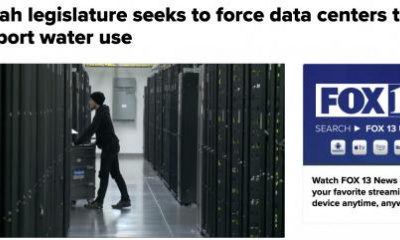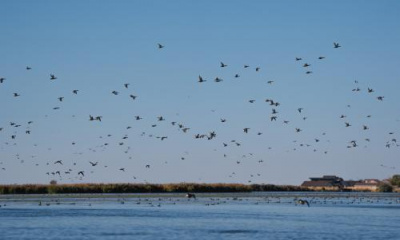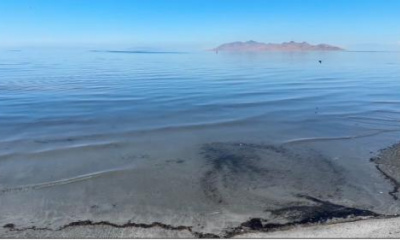‘I couldn’t be happier,’ Utah Gov. Spencer Cox said of lawmakers’ efforts in the 2022 Utah Legislative Session
For Utah lawmakers, it was the year of the Great Salt Lake.
After being accused of years of neglect from environmental groups, lawmakers answered a call from Gov. Spencer Cox who in December stood on the shores of Antelope Island to recommend $50 million for conservation efforts aimed at the lake.
This article is published through the Great Salt Lake Collaborative, a solutions journalism initiative that partners news, education and media organizations to help inform people about the plight of the Great Salt Lake — and what can be done to make a difference before it is too late.
“I couldn’t be happier,” Cox said of the efforts this session. “I am so grateful for Speaker Brad Wilson, who has really taken this on in the policy changes as well as the funding. It’s a great start and I think he would tell you that it’s just a start. We still have a lot to do but this is a very important first step.”
In February, lawmakers got a unique view of the lake as they piled into Utah Army National Guard Black Hawk helicopters. There, hundreds of feet above the Great Salt Lake — which in some areas is not really a lake anymore — they saw firsthand the devastating impacts of drought, coupled with a growing population sucking water out of the Weber, Bear and Jordan rivers.
“It really hit home how bad it is,” said Rep. Stephen Handy, R-Layton. “The shrinking Great Salt Lake is much worse than I thought it was. On the east side, there simply is no lake.”
What followed was a historic focus on the lake — from legislation spurred by Wilson’s newfound concern for the Great Salt Lake that will funnel $40 million toward conservation efforts, to a monumental shift in Utah’s long-standing “use it, or lose it” water rights, bill after bill flowed through the House and Senate with unanimous support.
But was it enough? The Deseret News reached out to experts, academics and stakeholders to hear their thoughts on the seven most important bills relating to the Great Salt Lake this session.
HB410 | Great Salt Lake Watershed Enhancement
In what lawmakers say is the most comprehensive bill for the lake to date, House Speaker Brad Wilson’s HB410 establishes the Great Salt Lake watershed enhancement program, which will oversee a water trust tasked with identifying conservation and sustainability projects with four goals:
- Retain and enhance water flows to the lake.
- Improve water quality and quantity in the watershed.
- Conserve and restore upstream habitats.
- Integrate water quality and management plans.
The trust will be infused with $40 million that will ultimately be awarded to an eligible conservation organization, which will allow them to acquire temporary water rights. Some stakeholders, like the Utah Rivers Council, would like to see a more permanent solution, noting that the water rights granted by the trust will expire after 10 years.
From Zach Frankel, executive director of the Utah Rivers Council:
The Great Salt Lake needs 2 million acre-feet of water and its own legally protected water rights. Without a plan to ensure the permanent protection of the lake’s water, the lake will continue to drop in the face of shrinking snowpacks and new water diversions. ... If protection isn’t permanent, it’s not really protection.
Still, the bill is being touted as a step in the right direction. From Marcelle Shoop, Saline Lakes Program director:
This substantial amount of funding, coupled with other bills before the Utah Legislature, signals a major commitment to the state’s future health — from the ecosystem to the economy. Devastatingly low water levels can negatively affect millions of migratory birds that rely on the lake, along with unique ecological marvels like microbialites, while also impacting recreation and brine shrimp harvesting and exposing communities around the lake to more airborne dust.
And from Bonnie Baxter, biology professor at Westminster College and director of Great Salt Lake Institute:
I’m impressed with the passion in this session, using the federal infrastructure funds to address the needs of the state of Utah. HB410 acknowledges the intricate state agencies’ management of Great Salt Lake and balances the interest of industry and residents with the biology of the ecosystem. The 10 million birds who visit annually have equal footing with salt companies and sailors. The story of saving Great Salt Lake is how getting water to the lake is great for ALL stakeholders! We are all on the same page.
HB429 | Great Salt Lake Amendments
While Wilson’s bill will provide funding for conservation efforts, Rep. Kelly Miles’ HB429 looks to ensure coordination among water agencies by creating the Great Salt Lake Watershed Integrated Water Assessment, under the Division of Water Resources.
The assessment, spurred by $5 million in initial funding, is an effort to close data gaps, develop an overall water budget for the lake and look for opportunities in the watershed to improve water management.
From Lynn de Freitas, executive director of Friends of Great Salt Lake:
HB429 is a demonstration of accountability. It’s an opportunity for us to really reckon with what we have. What do we know? What don’t we know? HB429 has life, and it gives me hope. We have the opportunity to address what we need to know and how we can make the best informed decisions about Great Salt Lake going forward. If we don’t know all of the parts of the whole, in terms of understanding groundwater contributions, and the hydrologic dynamic that relates to the information that we get to work with in real time, then it’s a little squishy. One of the contentions that Friends of the Great Salt Lake has, with all due respects, with the Division of Water Resources and their draft plan is the fact that they talk about doing work for Great Salt Lake, concerns about the decline in lake levels, and making sure they sustain the ecosystem, while at the same time talking about developing the Bear River.
And from Joanna Endter-Wada, professor of natural resource policy and social science at Utah State University:
Water is complicated, the way it travels through different parts of the system — through the air, through the rivers, through the soil. Having a more integrative perspective is helpful so that we’re managing it as one water — that’s a concept in the water world — but it’s also very similar to integrated water resource management and we’ve divided water legally, conceptually, management-wise into underground water, surface water and so on ... but realizing that they’re all connected at some level is important. I think those efforts to try to work together, to try to integrate agencies dealing on the management side, trying to integrate perspectives from the scientific side will help us move in a direction that will give us greater capacity to address the issues of the lake.
HB33 | Instream Water Flow Amendments
In what he called “the most important piece of water legislation that we will see,” Rep. Joel Ferry’s HB33 will add a third option to Utah’s long-standing “use it, or lose it” water rights by allowing “sovereign lands” to be designated as a beneficial use for water. That designation includes the Great Salt Lake.
Now, holders of water rights can lease their water for a period of up to 10 years without losing their rights.
Ferry used his own farm as an example. For years, he’s grown wheat which sells for so cheap that he rarely earns a profit. But he still grows it knowing he could lose his water rights if he doesn’t. Downriver is the Bear River Bird Refuge, which under HB33 could pay him for some of his water — that water will then stay in the watershed, while Ferry won’t lose his rights.
From Jack Ray, chairman of the Great Salt Lake Alliance and president of the Utah Waterfowl Association:
Utah’s water rights system takes a dim view of wasted water. In doing so, it sometimes perpetuates the inefficiency it seeks to avoid. This can hobble the water right holders and limit the water’s full benefit. For example, some have argued that any water reaching Great Salt Lake is wasted — and therefore available to be diverted away from the lake. This attitude has prevented dedication of water to Great Salt Lake out of fear of losing a vested right. Rep. Ferry has removed this barrier. Rep. Ferry drafted HB33 with an eye towards honoring long-standing water rights while providing a sensible framework for allowing the dedication of water for use on sovereign lands — like Great Salt Lake. The bill (a) assures water rights holders that their rights won’t be lost if they are used in the lake and (b) sets guardrails on the water’s use, such as what is necessary to maintain the lake’s aquatic environment. There is an increasing awareness that water used in the lake builds our snowpack, keeps our air clear, provides recreation, and sustains industries — all while anchoring a 10 million bird migratory pathway that stretches from the Arctic to Argentina. By sweeping aside impediments to the use of water on sovereign land, Rep. Ferry has opened a channel for water to flow to Great Salt Lake.
HB157 | Sovereign Lands Revenue Amendments
For years, Utah has been able to funnel money from the Sovereign Lands Management account, which is funded by royalties from industry operating on the state’s sovereign lands, including the Great Salt Lake.
According to Rep. Timothy Hawkes, R-Centerville, each year there’s about $10 million going into the account, and $10 million spent.
Sometimes there’s a surplus, and the Legislature uses it for various projects — most recently, to keep Utah’s national parks open during the pandemic. Rep. Hawkes’ HB157 would ensure that money stays on sovereign lands, with an emphasis on the Great Salt Lake.
“A lot of the revenue that’s derived from the Great Salt Lake goes to purposes that don’t have anything to do with the Great Salt Lake,” Hawkes said. His bill looks to accomplish three things:
- Requires money in the Sovereign Lands Management account to be used for projects that benefit state sovereign land.
- Asks that the source of the revenue is the main benefactor of the account’s funds — if most of the money stems from industry on the Great Salt Lake, that money will go toward the Great Salt Lake.
- Establishes a Great Salt Lake account that will collect new royalties made off the lake, especially coming from future lithium mining. Hawkes says with the proliferation of electric vehicles, companies will likely try to mine lithium-rich areas of the lake.
From Jaimi Butler, professor at the Westminster School of Arts and Sciences and coordinator for the Great Salt Lake Institute:
This bill will make it so money that is generated at Great Salt Lake on state land stays at Great Salt Lake. There is good precedent for this ... with the Great Salt Lake Ecosystem Program. All money that brine shrimp harvesters pay in permit fees goes into the Utah Division of Wildlife Resources’s Great Salt Lake Ecosystem Program, which works to manage and conserve the wildlife of the lake. Since its inception nearly 30 years ago, the industry and the state have worked together to create a sustainable fishery. Additionally, much of this foundational ecosystem research has been funded by the brine shrimp industry through Great Salt Lake Ecosystem Program.
HB242 | Secondary Water Metering Amendments
With water scarcity top of mind, there was a big push for metering of secondary water.
It is estimated that a metered water connection can achieve water savings of up to 30% as users grow more conscientious about what they are putting on their landscaping.
If the entire state were to conserve water at that rate, “the equivalent of a Jordanelle Reservoir could be saved,” HB242’s sponsor, Rep. Val Peterson, R-Orem, said.
The bill is propped up by over $200 million from the American Rescue Plan Act, which would cover 70% of the cost to install a meter for the first two years. After 2023, the reimbursement would decline on an annual basis, which Peterson says will incentivize users and suppliers to act quickly.
According to the bill, there are 221,000 unmetered secondary water connections in Utah — Peterson says it will cost about $386 million to meter those connections by 2030.
The bill received several amendments:
- An entity already under a water management plan with the Division of Natural Resources is eligible for an exemption.
- Entities in a county of a fifth and sixth class — the least populated counties in the state — are eligible for an exemption if water metering would exceed 25% of the secondary water system.
- Cities that already meter secondary water can apply for a grant of up to $2 million to spur other water conservation projects in the area.
From the nonprofit Western Resource Advocates:
Utah has some of the highest per-person water use in the U.S., in part, because of the prevalence of unmetered secondary water systems, which supply untreated irrigation water for outdoor water use. Users of these systems pay a flat monthly or annual fee regardless of how much water they use. It’s like an all-you-can-eat buffet that incentivizes wasteful water use. HB242 requires water suppliers to meter new and existing pressurized secondary water connections; imposes penalties for failure to comply with metering requirements; and provides $200 million in grants to fund metering of certain pressurized secondary water services. If all secondary water in Utah was metered, it could save at least 80,000 acre-feet, the equivalent amount of water to serve the annual water demand of 400,000 Utahns.
HB121 | Water Conservation Modifications
Brown grass became a point of pride for some Utahns who tried to scale back water use over the summer as the state slogs through a historic drought.
To that end, lawmakers earmarked $5 million under HB121 to cover up to 50% of landscaping costs if a homeowner wants to xeriscape their lawn, or replace it with drought-resistant plants.
The bill also requires state facilities to reduce outdoor water use by 25% by 2026.
But to the chagrin of water and environmental groups, lawmakers amended the bill and removed language that would have prevented cities from requiring grass.
From Joanna Endter-Wada, professor of natural resource policy and social science at Utah State University:
(This bill) incentivizes water conservation at state government facilities by requiring a schedule for reductions in outdoor water use, stipulating adherence to certain irrigation best practices and provides financial incentives through matching funds for turf removal and replacement with low water landscaping. My opinion is that turf replacement with drought resistant and low water use turf varieties should be considered in landscaping replacement options.
And from Zach Frankel, executive director of the Utah Rivers Council:
This bill was substituted once and amended once, each time getting weakened in its original provisions. ... What was removed from this bill was the measure which would have prevented cities from requiring grass. Cities can still require grass, which is a very silly and outdated requirement. By removing that measure, it marks the 6th or 7th time a lawmaker has tried to prevent cities from requiring grass in Utah, yet failed to get the measure passed.
HB37 | State Water Policy Amendments
Rep Kevin Stratton’s HB37 is a relatively minor change to the state’s water policy — include the recharging and recovery of aquifers.
And while experts say water stored in aquifers is immune to the evaporation problems that impact reservoirs, and therefore is a good strategy for conservation, there are concerns about how the policy could impact the Great Salt Lake.
From Steve Erickson with the Great Basin Water Network:
This has some value accounting for losses associated with evaporation if you’re building reservoirs. We have a number of reservoirs, and they’re still functioning — it’s a good thing that we have them in this mega drought. But building more is really quite expensive. It may be less environmentally damaging to inject water into the ground and store it for future use, while also allowing some of that to work in conjunction with surface waters like rivers and lakes. But there are also some real cons. If you’re taking water out of streams, rivers or groundwater in order to store it in other groundwater sources, the benefits to the environment are diminished or lost. For instance, water aquifer storage done in Salt Lake City or in the Wasatch Front along the tributaries to Great Salt Lake reduces flows to the lake or at least delays by decades the arrival of that water to Great Salt Lake. So if the goal is to shore up the levels of the lake, then aquifer storage could be counterproductive to that endeavor.
And from Zach Frankel, executive director of the Utah Rivers Council:
This bill has about as much to do with saving the Great Salt Lake as growing apples has to do with growing oranges. It supports Bear River Development, which means it supports drying up the Great Salt Lake.








